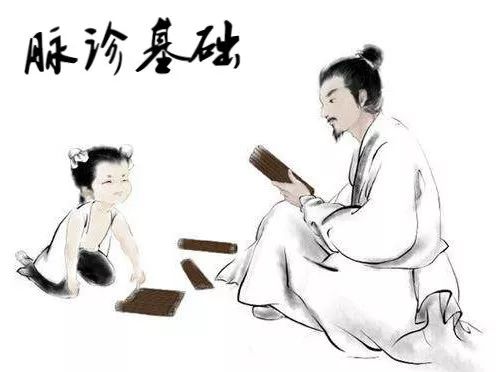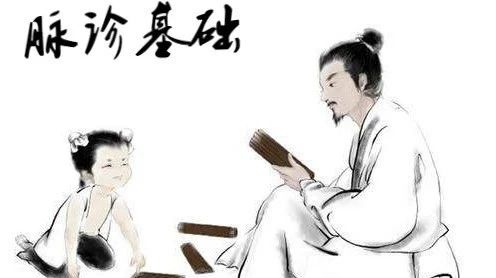The ancient pulse diagnosis system most favored is the 28 pulses of Li Shizhen’s Binhu Pulse Studies, which serves as the foundation for our TCM diagnostic lectures on pulse diagnosis, complementing the 25 pulse elements of modern pulse diagnosis by Qi Xianghua. I believe the greatest advantage of systematic pulse diagnosis lies in its physical language that describes pulse characteristics, helping beginners find a starting point and allowing experienced practitioners to identify unnamed pulse methods or sensations, providing objective indicators for the complex and chaotic pulse methods, and offering practice methods for those dedicated to studying pulse diagnosis but struggling to find the right approach.
In the systematic pulse diagnosis training class, my senior colleagues demonstrated their consistency in pulse diagnosis. Multiple practitioners diagnosed the same person’s pulse, and using systematic pulse diagnosis for analysis, the pulse elements, background pulse, and local pulse characteristics, as well as the analysis of constitution, personality traits, and etiology, were consistent.
The pulse patterns recorded in the Neijing are far more complex than those of later generations. Typical pulse names include:
Floating, Deep, Large, Small, Slippery, Rough, Fine, Rapid, Slow, Intermittent, Hooked, Surging, Restless, Rapid, String-like, Moist, Soft, Weak, Light, Empty, Long, Full, Strong, Weak, Faint, Urgent, Scattered, Hair-like, Firm, Nourishing, Stony, Throbbing, Quiet, Tight, Knotted, Moving, Short, Slow, Absent, Horizontal, Thin, Gradual, Few, Even, Suspended, Drum-like, Urgent, Strong, Flooding, Full, Sparse, and others, totaling nearly a hundred types when including atypical, composite, and some difficult-to-interpret pulse names.
Traditional 28 Pulses
Floating Pulses: Floating, Surging, Moist, Hooked, Drum-like, Scattered
Deep Pulses: Deep, Hidden, Firm, Weak
Slow Pulses: Slow, Knotted, Rough, Slow
Rapid Pulses: Rapid, Moving, Quick, Urgent
Empty Pulses: Empty, Fine, Weak, Intermittent, Short
Full Pulses: Full, Tight, Long, Slippery, String-like
25 Pulse Element Factors
Pulse Body Factors: Left and Right, Internal and External, Curved and Straight, Cold and Heat, Clear and Turbid, Floating and Deep, Up and Down, Thick and Thin
Pulse Wall: Thickness, Contraction and Expansion, Rigid and Soft
Pulse Wave: Arrival and Departure, Length, Movement and Stillness, Slow and Rapid, Weak and Strong, High and Deep, Knotted and Intermittent
Blood Flow: Slippery and Rough, Advance and Retreat, Withering and Flourishing, Strong and Weak, Convex and Concave, Sparse and Dense, Rapid and Slow
In traditional pulse patterns, physical language describes: Floating, Deep, Slow, Rapid, Long, Short, Knotted, Fine.
These pulse patterns are relatively easy to understand. However, many difficult-to-grasp pulse patterns use metaphorical means to aid our learning. Their descriptions include:
“Surging”: Like waves, it rises and falls.
“Moist”: Moist and floating, light to press, like floating cotton on water.
“Hooked”: Hooked and floating, soft like scallions, pressing reveals a central emptiness.
“Drum-like”: Drum-like pulse feels like pressing on a drum skin, hooked and string-like, indicating cold and empty pulse.
“Scattered”: Scattered like willow fluff, drifting and unpredictable.
“String-like”: Straight and long, like pressing on a guitar string.
“Tight”: The pulse comes tight, like pressing on a twisted rope.
Here, I will not list them all. In ancient times, many practitioners were literate and could pass down literature. A phrase like “scattered like willow fluff” draws us into a romantic imagery of spring, where it dances lightly like snow, flowers, and feathers, ethereal like a dream. A phrase like “like pressing on a guitar string” seems to echo with melodious and clear sounds, conjuring images of ancient scholars and beauties playing music. Yet, “the pulse theory is subtle, its principles easy to discern, but difficult to clarify under the fingers.” The ancients provided us with vivid descriptions but did not give us methods to master these pulse patterns.

Pathological Pulses
Pathological changes reflected in the pulse are called pathological pulses. Generally speaking, any pulse outside the normal physiological range and individual physiological characteristics is considered a pathological pulse.
In the development of pulse studies, due to different experiences in pulse palpation, the naming of pulse patterns has also varied. The earliest pulse study book in China, Pulse Classic, proposed twenty-four pulse patterns, while Jingyue Quanshu proposed ten types, and Binhu Pulse Studies proposed twenty-seven types. Li Shicai’s Diagnosis with Correct Vision added pathological pulses, thus modern discussions often revolve around twenty-eight types. Pulse patterns are observed through four aspects: position, number, shape, and momentum. For example, floating and deep refer to different pulse positions, slow and rapid refer to different frequencies, and empty and full refer to the strength of the pulse (momentum). Some pulse patterns combine several aspects, such as surging and fine, which differ in shape and momentum.

Differentiation of Similar Pulses
Among the twenty-eight pathological pulses, some are very similar and easily confused, requiring differentiation. Throughout history, physicians have accumulated rich experience in pulse differentiation. For example, Wang Shuhe pointed out some similar pulse patterns, and Li Shizhen compiled a more detailed pulse song. Xu Lingtai further specified methods for pulse differentiation, namely using comparative methods of similar pulse patterns (and also contrasting methods with opposite pulse patterns), which is a good way to differentiate similar pulses.
Here are some differentiations of similar pulses:
Floating Pulse vs. Empty, Hooked, Scattered Pulses: All four are similar, with shallow pulse positions, but the difference is that the floating pulse is abundant when lifted, slightly reduced when pressed, and not empty; the pulse shape is neither large nor small. The empty pulse is large and weak, and pressing reveals emptiness; the hooked pulse is large and weak, with a central emptiness, like pressing on a scallion; the scattered pulse is floating and weak, drifting without roots, and pressing does not yield.
Deep Pulse vs. Hidden, Firm Pulses: All three have deep pulse positions, and light palpation does not respond. The difference is that the deep pulse is obtained with heavy pressure; the hidden pulse is deeper than the deep pulse, touching the tendons and bones, thus not responding to heavy pressure, requiring pushing on the tendons and bones to obtain it, and may even become hidden and unobservable; the firm pulse is solid, large, and firm, not moving under pressure.
Slow Pulse vs. Relaxed Pulse: Both are measured by breaths; the slow pulse has less than four beats per breath; the relaxed pulse is slightly faster than the slow pulse, with four beats per breath, showing a gentle and relaxed pulse.
Rapid Pulse vs. Slippery, Quick Pulses: The slippery pulse and rapid pulse have similarities; the slippery pulse is smooth and flowing, while the rapid pulse indicates frequency. The slippery pulse refers to shape and momentum, while the rapid pulse refers to frequency, with more than five beats per breath. Binhu Pulse Studies states: “Do not confuse slippery and rapid as the same; rapid pulse is only based on frequency.” Rapid and quick pulses are also measured by breaths, with the quick pulse being faster than the rapid pulse, having seven or eight beats per breath, corresponding to a pulse rate of over 140 beats per minute.
Full Pulse vs. Surging Pulse: Both have a strong and full momentum, but the surging pulse resembles turbulent waves, abundant and full under the fingers, rising and falling, clearly floating; while the full pulse is long, solid, and strong, responding with force, both rising and falling abundantly, hence the saying “floating and deep both are large and long, responding with strength without emptiness.”
Fine Pulse vs. Weak, Moist, Slippery Pulses: All four have fine and weak shapes. However, the fine pulse is small but responds clearly; the weak pulse is extremely fine and soft, pressing may feel like it is about to disappear, sometimes difficult to count; the weak pulse is deep and fine but without strength, while the moist pulse is floating and fine but without strength, indicating a pulse position opposite to the weak pulse, easily felt with light pressure but not obvious with heavy pressure.
Hooked Pulse vs. Drum-like Pulse: Both have a central emptiness, but the hooked pulse is large and weak with central emptiness, like pressing on a scallion, indicating a soft pulse; the drum-like pulse is large and strong under pressure, string-like and urgent with central emptiness, like pressing on a drum skin, indicating a harder pulse.
String-like Pulse vs. Long, Tight Pulses: The string-like pulse is similar to the long pulse, but the long pulse exceeds the local area, like following a long pole, long but not urgent; the string-like pulse is long but tense, like pressing on a guitar string. Yishu states: “Long is similar to string but more abundant; string pulse is urgent, long pulse is relaxed.” The string pulse resembles the tight pulse; both have tense momentum, but the string pulse feels like pressing on a guitar string, without urgency, while the tight pulse feels like pressing on a taut rope, with a tense momentum, and the tight pulse is larger than the string pulse.
Short Pulse vs. Moving Pulse: Both have a short and contracted appearance, but the short pulse is short in shape and often combined with slowness, not filling three positions; the moving pulse resembles a bean, often combined with slippery and rapid characteristics, Yishu states: “Short resembles moving but is weaker; moving pulse is slippery and rapid, while short pulse is moist and must be slow.”
Knotted, Intermittent, Urgent Pulses: All belong to arrhythmic pulses with pauses, which is a commonality among the three. However, the knotted and urgent pulses have irregular pauses, with short pause times; while the intermittent pulse has regular pauses, and the pause times are longer, which distinguishes the knotted and urgent pulses from the intermittent pulse. The knotted pulse is slow with pauses, while the urgent pulse is rapid with pauses.
Appendix: Contrasting Method
Floating Pulse vs. Deep Pulse: These are two opposing pulse patterns in terms of position; the floating pulse is superficial, easily obtained with light pressure, indicating the exterior and belonging to Yang; the deep pulse is deep, not responding to light pressure, requiring heavy pressure to obtain, indicating the interior and belonging to Yin.
Slow Pulse vs. Rapid Pulse: These are two opposing pulse patterns in terms of speed; the slow pulse beats slower than the normal pulse, with less than four beats per breath; the rapid pulse beats faster than the normal pulse, with more than five beats per breath, with the slow pulse indicating cold and the rapid pulse indicating heat, also indicating emptiness.
Empty Pulse vs. Full Pulse: These are two opposing pulse patterns in terms of strength (momentum); the empty pulse has no strength in all three positions; the full pulse has strength in all three positions, indicating the distinction between emptiness and fullness.
Slippery Pulse vs. Rough Pulse: These are two opposing pulse patterns in terms of smoothness; the slippery pulse flows smoothly and is round under the fingers; the rough pulse is difficult and stagnant, extremely unyielding, with ancient descriptions likening the rough pulse to a light knife scraping bamboo. The term “light knife scraping bamboo” indicates that the pulse does not flow smoothly under the fingers.
Surging Pulse vs. Fine Pulse: These are two opposing pulse patterns in terms of size and momentum; the surging pulse is large, full, and strong, with a strong incoming and weak outgoing momentum; the fine pulse is small and thread-like, often weak and without strength, but responds clearly.
Long Pulse vs. Short Pulse: These are two opposing pulse patterns in terms of length; the long pulse exceeds the local area, indicating a pulse momentum that exceeds the local area, likened to following a long pole; the short pulse is short in shape, not reaching the local area, indicating a pulse momentum that is short and does not reach the local area.
Tight Pulse vs. Relaxed Pulse: These are two opposing pulse patterns in terms of tension; the tight pulse is tense and strong, like pressing on a twisted rope; the relaxed pulse is gentle, with four beats per breath.

Strange Pulses
Any pulse without the root of the stomach spirit is called a strange pulse, also known as true victorious pulse, defeated pulse, dead pulse, or absent pulse. These are often seen in the later stages of disease, when the qi of the organs is exhausted, and the stomach qi is lost. In the Yuan dynasty, Wei Yilin’s Effective Formulas of World Medicine listed ten types of strange pulses, called “ten strange pulses.” Later physicians removed the “suspended knife,” “turning bean,” and “hemp urgent” from the ten strange pulses, calling them “seven unique pulses.” These pulse patterns can be encountered clinically, and the shapes and clinical significance of the seven unique pulses are described as follows.
1. Boiling Pot Pulse: The pulse is on the skin, extremely floating and rapid, with an uncountable number of beats, like boiling water in a pot, floating without roots. This indicates extreme Yang heat, with Yin fluids exhausted, and is a sign of impending death.
2. Fish Swimming Pulse: The pulse is on the skin, with a fixed head and a swaying tail, seeming to exist and not exist, like a fish swimming in water. This indicates extreme cold of the three Yin, with Yang lost to the exterior.
3. Shrimp Swimming Pulse: The pulse is on the skin, like a shrimp swimming in water, sometimes leaping away, sometimes returning, with a rapid and restless appearance. This indicates solitary Yang without support, restlessness, and is a sign of large intestine qi exhaustion.
4. Leaky Roof Pulse: The pulse is between the muscles, like a leaky roof dripping, with a long pause between drops, indicating extremely slow and weak pulses. This indicates the exhaustion of stomach qi and Yingwei.
5. Sparrow Pecking Pulse: The pulse is between the muscles, with continuous rapid beats, irregularly three to five times, stopping and resuming, resembling a sparrow pecking at food. This indicates that the qi of the grain has been exhausted internally.
6. Untying Rope Pulse: The pulse is between the muscles, sometimes tight and sometimes loose, resembling a tangled rope. This is a pulse that is sometimes fast and sometimes slow, scattered and disordered. This indicates the loss of both kidney and Mingmen qi.
7. Stone Bouncing Pulse: The pulse is beneath the muscles, like a finger bouncing on a stone, with no softness or gentleness. This indicates the exhaustion of kidney qi.
In an era without today’s advanced diagnostic methods, traditional pulse diagnosis played a significant role for a period. The outstanding contributions of TCM to the Chinese nation cannot be erased. Its brilliant light continues to shine throughout history. However, with social progress, many ancient difficult and strange diseases or diseases that have never been seen before have become common today. Increased life pressure and changes in people’s psychological states have led to more frequent emotional illnesses. Therefore, based on the inheritance of ancient pulse methods, we are required to innovate and develop to adapt to the changes in the prevalence of contemporary diseases. Establishing standardized operations for pulse diagnosis and evaluating techniques is increasingly important.
— THE END —
▶ Copyright Statement:
1. Source: This article is excerpted from the 360 Personal Library, edited by Zhu Houxi.
2. This platform aims to disseminate knowledge of TCM culture, and the copyright belongs to the relevant rights holders. We respect knowledge and labor; please retain copyright information when reprinting. If there are any improper uses, please feel free to contact us for negotiation. Contact (WeChat): 936532881
3. We welcome everyone to submit articles; submission email: [email protected]


